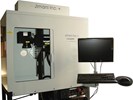ARTICLES BY JIM EARMAN
-
Large Field Marking With Steered Beam Fiber Laser Marking Systems9/22/2016
Very large marking fields are not practical with steered beam fiber laser marking systems. Marking fields larger than about 12 inches square produce focused spot sizes that are too large to provide sufficient power density for engraving applications, and linewidths too broad for detailed marking applications.In order to achieve large marking fields with steered beam fiber laser marking systems, the information to be marked must be sectioned into “tiles” that are no larger than the marking field. This article discusses the use of galvo drive systems in large field marking and how it is done with good quality hardware and software.
-
Laser Marking Metal For Medical Applications1/14/2016
Medical product marking and decoration is used for inventory control, process management and internal tracking, branding, and functionality. In many cases, lasers provide the preferred means of marking and identifying those products.
-
Laser Marking 401: Pricing A Fiber Laser Marking System9/4/2015
We’re frequently asked the question, “How much does a fiber laser marker cost?” The answer to that question depends on the application and the configuration of the system. Factors such as the materials being marked, depth and cycle time requirements, and the required marking area all must be considered, as well as your own expectations for reliability, training, and support.
-
Laser Marking 3014/1/2015
In this article we would like to discuss the types of marking that can be accomplished with fiber lasers.
-
Laser Marking 201: Laser Marking Various Types Of Products1/6/2015
In our first article, we delved into the basics of using a steered beam fiber laser marking system and how to make a mark on just about any type of material. We will now dig into the specifics of making a mark on a particular part shape, including flat parts, round and curved parts, stepped parts, irregularly shaped parts, and all of the different nuances in between. Throughout this article, we provide best practices to consider when marking these differently shaped parts.
-
Introduction To Fiber Laser Marking9/4/2014
While laser marking systems employ exactly the same principle as burning leaves with a magnifying glass, the process is slightly more complicated. Instead of sunlight being passed through a simple lens, laser light is passed through a more complex lens — an f theta lens. And, while sunlight consists of many colors or wavelengths, laser light has the property of being monochromatic. This article provides an introduction to fiber laser marking and explains the three most important settings that can affect how a part is marked.





